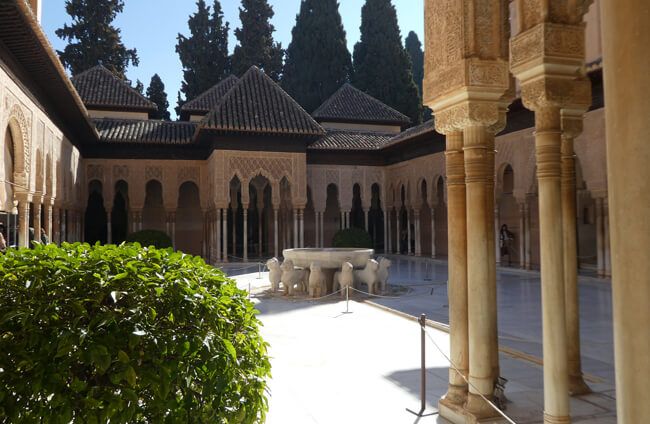-

 Know, the true nature of your Beloved.
Know, the true nature of your Beloved.
In His loving eyes, your every thought,
Word and movement is always –
Always Beautiful.
~ Hafiz
Sacred Architecture

The Alhambra
Reputedly the most visited tourist site in the world after the Taj Mahal, the Alhambra stands loftily as an icon to the seven hundred year rule of Islam in Spain, that was typified by tolerance and an enormous educational, cultural and religious output, possibly never to be matched again in European history.
The conquest of the Visigoths in al-Andalus, Spain, by the Muslims from north Africa led to an era of Muslim rule that cultivated a culture when Christians, Jews and Muslims lived side by side and, despite their differences, nourished a complex culture of tolerance, called ‘La Convivencia’ – The Coexistence. This culture saw no contradiction in pursuing the truth, whether philosophical, scientific, medical or religious across confessional lines. This vision of a culture of tolerance recognized that difference and ambiguity in the shaping of individuals as well as their cultures, was both enriching and productive.
This is the opposite of the fundamentalist interpretation that forms part of each of these three religions today, that have brought such disastrous consequences to the world.
From the generally religious community, Al-Andalus was blessed with an extraordinary quartet of towering religious figures who shared their ideas and inspired each other; Ibn Arabi – Sufism’s Greatest Master, Moses de Leon – Judaism’s greatest Kabbalist, Averroes – the ‘Muslim ‘Commentator and Maimonides – Judaism’s ‘second Moses’. In fact, the soring meditations of Sufism’s Ibn Arabi and the Jewish Kabbalist, Moses de Leon, are regarded by many scholars as the pinnacle of mystical spirituality of any era, in their respective faiths.
Although now a fragment of its former glory, travellers realise from the sensuality of its gardens and fountains, its profusion of fantastic ornament and the beauty of its setting, uniquely profiled against peaks of alpine grandeur, that the Alhambra is the embodiment of an Islamic civilization at its zenith. Ibn Zamrak, the Alhambra court poet, in 1380 described his home in the following poem:-
‘Stay awhile here on the terrace of the Alhambra and look about you,
This city is a wife, whose husband is the hill:
Girt she is by water and by flowers,
Which glisten at her throat
Ringed with streams; and behold the groves of trees which are the wedding guests, whose thirst is being assuaged by the water channels.
The Alhambra sits like a garland on Granada’s brow,
In which the stars would be entwined,
And the Alhambra (God preserve it) is the ruby set above that garland.
Granada is a bride whose headdress is the Alhambra, and whose jewels and adornments are its flowers.’
Over the centuries, Muslims and Jews were pushed south by the Christian Catholics, until the Alhambra became the last bastion of al-Andalus. In 1491, the last Nasrid king, Boabdil, surrendered the Alhambra to the king and queen of Castile and Aragon, which saw the end of ‘La Convivencia’ and the culture that supported it.
Sources:- ‘Alhambra’ by Michael Jacobs.
‘The Ornament of the World’ by Maria Rosa Menocal.
‘A Vanished World’ by Chris Lowney.
